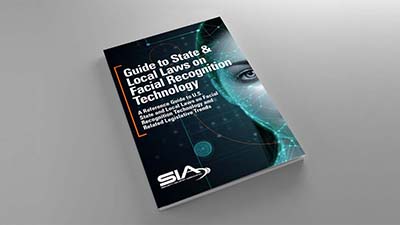SIA releases updated Guide to State & Local Laws on Facial Recognition Technology
By SSN Staff
Updated 9:04 PM CST, Tue December 10, 2024
SILVER SPRING, Md.—The Security Industry Association (SIA) has released an updated version of its Guide to State & Local Laws on Facial Recognition Technology, a reference guide to U.S. state and local laws on facial recognition technology and related legislative trends.
Currently, 13 states and 23 local jurisdictions have laws specifically addressing facial recognition technology. It can be challenging to navigate this legal landscape, as all such laws are relatively new and untested. Some are also very complex.
 According to SIA, it is imperative that any business supplying and any commercial or government entity using facial recognition technology products in a jurisdiction where such laws apply should consult an attorney to ensure compliance; however, it is hoped that this guide can serve as a starting point regarding the requirements and provide additional policy perspectives that could assist with informed compliance efforts.
According to SIA, it is imperative that any business supplying and any commercial or government entity using facial recognition technology products in a jurisdiction where such laws apply should consult an attorney to ensure compliance; however, it is hoped that this guide can serve as a starting point regarding the requirements and provide additional policy perspectives that could assist with informed compliance efforts.
The importance of facial recognition technology
Advances in computing power and capabilities thanks to artificial intelligence (AI), combined with rapid improvements in the quality of photo and video technology in the last 15 years, have allowed facial recognition technology to develop and mature. Simply put, facial recognition software compares and matches facial images. This is done using an algorithm to compare a presented image with one or more “enrolled” images, after the images are converted to unique numerical versions readable by that specific system and compared for similarity.
Facial recognition has three primary functions, with differing outputs.
- Verification: Verifying a person matches an enrolled image associated with their identity
- Output: An automated yes/no decision to authenticate
- Identification: Determining that an image matches one or more images enrolled in a database
- Output: Either an automated yes/no decision of some kind or flagging a likely match or non-match for further human review
- Investigation: Helping determine whether a matching image is in a database for an investigative purpose
- Output: A series of images from a database with the highest similarity scores are provided for review
These functions have proven to be incredibly useful across many types of applications. The purposes can be vastly different from one another, presenting application-specific implementation considerations – from verifying an identity in a remote online transaction to physically opening a door for an authorized person to helping law enforcement investigators narrow down a set of possible matching photos.
This technology is particularly important to the security field because it enhances capabilities of solutions like video security, access control and identity management systems that help end users secure their facilities, employees and patrons against the threat of violence, theft or other harm.
SIA noted that the use of facial recognition technology has benefited our society in countless but underpublicized ways – helping law enforcement find missing children, fight human trafficking, find dangerous criminals and bring sexual predators to justice. Other benefits extend to everyday life, as the technology allows an individual to conveniently and securely prove their identity to enter a venue, board a plane, perform online transactions and seamlessly access personalized experiences.
At the same time, public concerns have surfaced over whether the technology is accurate or could be used in ways that raise privacy and civil liberties concerns. As a result, there is a clear need to bolster public trust, in particular that law enforcement agencies are leveraging accurate facial recognition software tools in a lawful, effective and nondiscriminatory manner that benefits all our residents and communities. It is critical to address these concerns, which have prompted most legislation that has been enacted regarding facial recognition.
SIA members can download the guide for free at https://www.securityindustry.org/member-resources/.
Comments